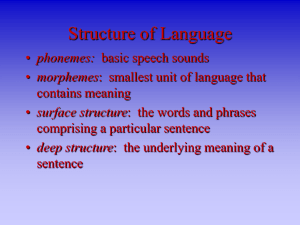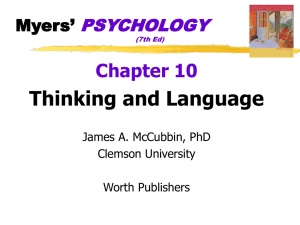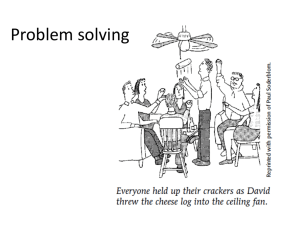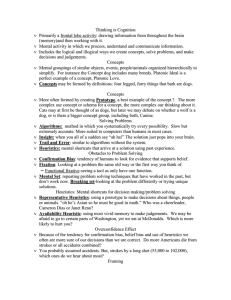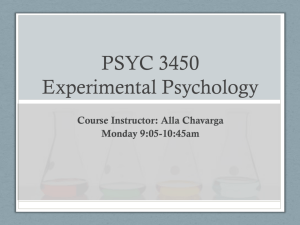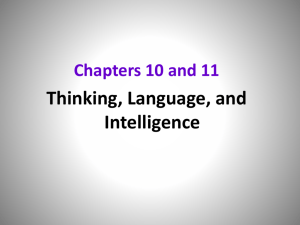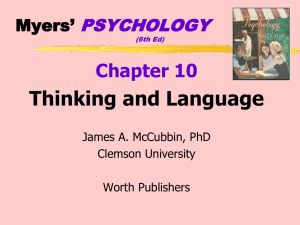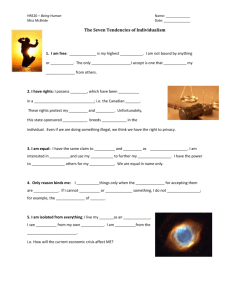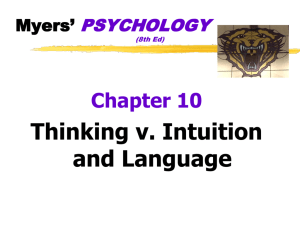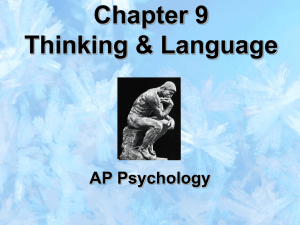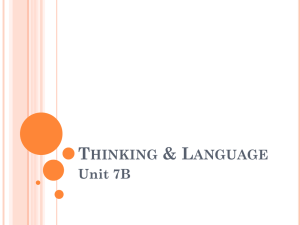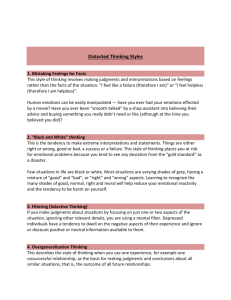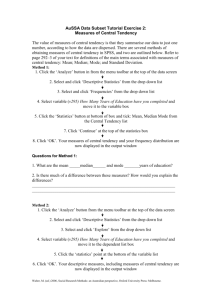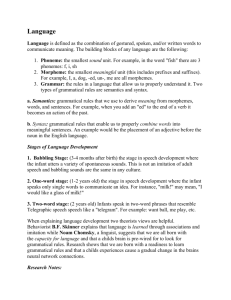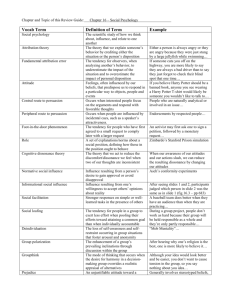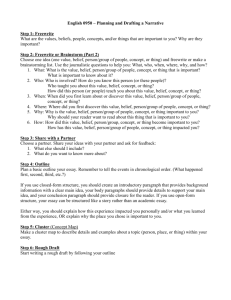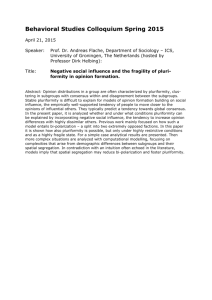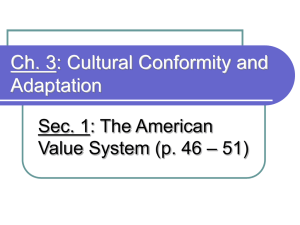Chapter 10 Lecture Notes: Thinking and Language
advertisement
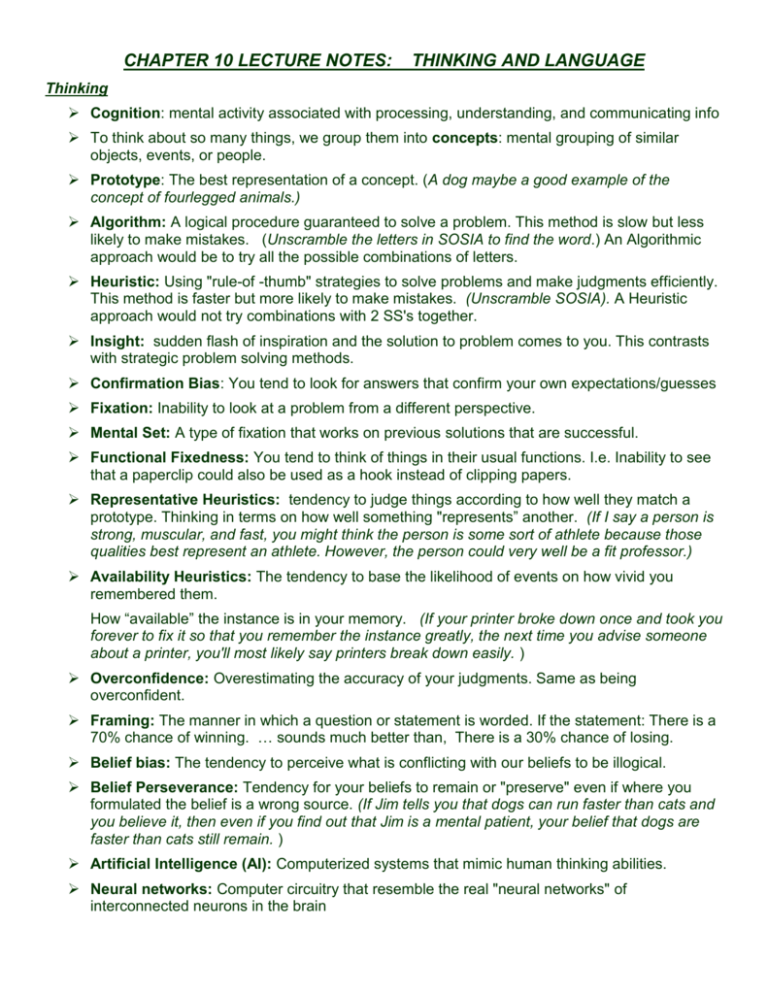
CHAPTER 10 LECTURE NOTES: THINKING AND LANGUAGE Thinking Cognition: mental activity associated with processing, understanding, and communicating info To think about so many things, we group them into concepts: mental grouping of similar objects, events, or people. Prototype: The best representation of a concept. (A dog maybe a good example of the concept of fourlegged animals.) Algorithm: A logical procedure guaranteed to solve a problem. This method is slow but less likely to make mistakes. (Unscramble the letters in SOSIA to find the word.) An Algorithmic approach would be to try all the possible combinations of letters. Heuristic: Using "rule-of -thumb" strategies to solve problems and make judgments efficiently. This method is faster but more likely to make mistakes. (Unscramble SOSIA). A Heuristic approach would not try combinations with 2 SS's together. Insight: sudden flash of inspiration and the solution to problem comes to you. This contrasts with strategic problem solving methods. Confirmation Bias: You tend to look for answers that confirm your own expectations/guesses Fixation: Inability to look at a problem from a different perspective. Mental Set: A type of fixation that works on previous solutions that are successful. Functional Fixedness: You tend to think of things in their usual functions. I.e. Inability to see that a paperclip could also be used as a hook instead of clipping papers. Representative Heuristics: tendency to judge things according to how well they match a prototype. Thinking in terms on how well something "represents” another. (If I say a person is strong, muscular, and fast, you might think the person is some sort of athlete because those qualities best represent an athlete. However, the person could very well be a fit professor.) Availability Heuristics: The tendency to base the likelihood of events on how vivid you remembered them. How “available” the instance is in your memory. (If your printer broke down once and took you forever to fix it so that you remember the instance greatly, the next time you advise someone about a printer, you'll most likely say printers break down easily. ) Overconfidence: Overestimating the accuracy of your judgments. Same as being overconfident. Framing: The manner in which a question or statement is worded. If the statement: There is a 70% chance of winning. … sounds much better than, There is a 30% chance of losing. Belief bias: The tendency to perceive what is conflicting with our beliefs to be illogical. Belief Perseverance: Tendency for your beliefs to remain or "preserve" even if where you formulated the belief is a wrong source. (If Jim tells you that dogs can run faster than cats and you believe it, then even if you find out that Jim is a mental patient, your belief that dogs are faster than cats still remain. ) Artificial Intelligence (AI): Computerized systems that mimic human thinking abilities. Neural networks: Computer circuitry that resemble the real "neural networks" of interconnected neurons in the brain Language Language: combination of gestured, spoken, and/or written words to communicate meaning. Phoneme: smallest sound unit. (In fish there are 3 phonemes: f, i, sh) Morpheme: smallest meaningful unit (this includes pre/suffices). (I, a, dog, -ed, un-, me - are all morphemes.) Grammar: rules in a language that allow us to properly understand it. Semantics: How we get meaning from morphemes, words, and sentences. Syntax: How to combine words into meaningful sentences. Babbling Stage: (3-4 months after birth) stage in speech development where the infant utters sounds like the family language. One-word stage: (1-2 years old) A stage in speech development where the infant speaks single words Two-word stage: (2 years old) Infants speak in two-word phrases that resemble telegraphic speech - speech like a "telegram", (Want candy, me play, no eat...etc) A child can learn any language and will spontaneously invent meaningful words to convey their wishes. However, after age 7, the ability to master a new language greatly declines. Animals also communicate, whether by means of sound or behavior just as bees dictate the location of nectar with an elaborate dance. Allen Gardner and Beatrice Gardner, researchers of University of Nevada, successfully taught a chimpanzee to perform sign language as means of communication. Thinking and Language Linguistic Benjamin Lee Whorf’s Linguistic Relativity states language determines how we think. This is most evident in polylinguals (speaking 2 or more languages). (Someone who speaks English and Chinese will feel differently depending on which language they are using. English has many words describing personal emotions and Chinese has many words describing inter-personal emotions.) However, thinking could occur without language. This is evident in pianists and artists where mental images nourish the mind. Therefore, thinking and language affect each other in an enduring cycle.
